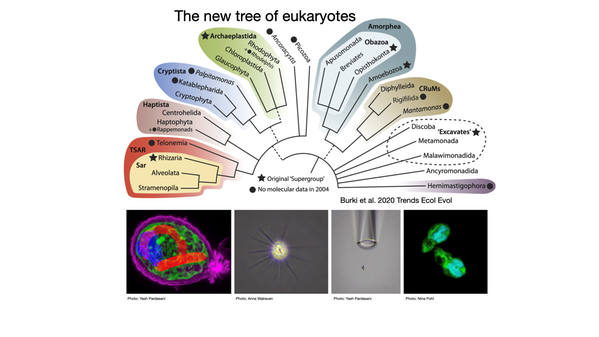Burkis Labb - Protist diversity and evolution

Microbes represent the vast majority of eukaryotic diversity, yet we have barely scratched the surface of this extraordinary reservoir of genetic information. Without better knowing this diversity of microbial eukaryotes (aka protists), it is difficult to comprehensively infer the major evolutionary transitions that shaped the tree of life. In my group, we are studying the fascinating diversity of protists to understand major events in the evolution of eukaryotes, in particular the origin and spread of photosynthetic organelles that allowed life as we know it to evolve.
About us
Principal Investigator: Fabien Burki
For the untrained eyes, it is tempting to think that life is mainly composed of organisms that we can see when we walk outside–animals, plants, even fungi if we look more carefully. In reality, however, most diversity is represented by microbial organisms, often unicellular and so tiny that they remain invisible to the naked eyes. This is true for the organisms that we often think of when we think of microbes–for example bacteria–but also and importantly for the comparatively more complex organisms known as eukaryotes. In the protist diversity and evolution lab, we are fascinated by the extraordinary diversity of microbial eukaryotes and the non-textbook biology that these understudied organisms represent. Our motto is that only by revealing and including the great diversity of protists in models of eukaryote evolution will we be able to better understand the processes that shaped the eukaryotic tree of life over the past 2 billion years.
Our main research question relates to the origin and spread of photosynthetic organelles in eukaryotes. The acquisition of these organelles–called plastids–by various endosymbioses throughout the tree of eukaryotes resulted in an explosion of diversity of primary producers (algae), which created the conditions necessary to the evolution of all other organisms. Thus, the origin of plastids has been one of the most important events in eukaryote evolution, but in spite of this importance it remains poorly understood.
In the lab we use an array of methods to study algae and–importantly–non-algal lineages that are closely related to algae to better understand how plastids were established by endosymbiosis. Currently our methods include: metagenomics, single-cell genomics, metabarcoding, culturing, microscopy, spatial proteomics.
If interested in our research, drop us an email [Fabien.burki @ ebc.uu.se] or drop by if in the area. For prospective students, we are always happy to try to accommodate MSc or BSc research projects.
